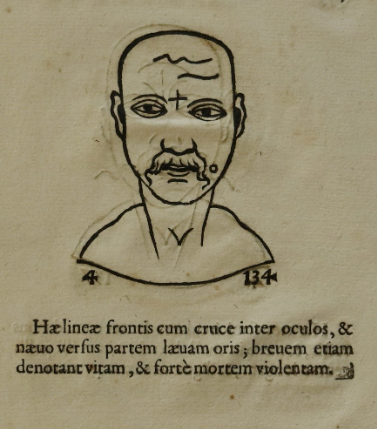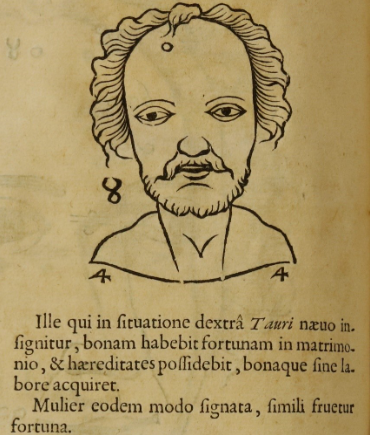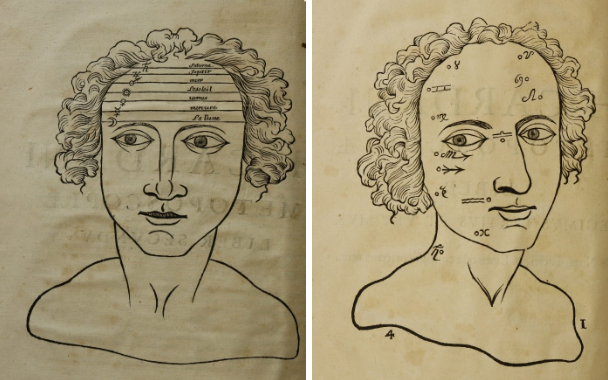
When you think of fortunetelling, what comes to mind? Tarot cards? Horoscopes? Chances are you’ve come across palmistry at some point, but what about metoposcopy?
Metoposcopy is, simply put, a form of divination that uses the lines on the subject’s forehead to interpret their personality and future. In this sense, it is a close relative of chiromancy, more familiarly known as palmistry. But while palm reading is still a well-known part of fortunetelling, metoposcopy has become much more obscure.
Metoposcopy is quite similar to physiognomy, a pseudoscience that claims it’s possible to discern a person’s character and personality from their facial characteristics. One of the most notable early modern works on the subject, Italian scholar Giambattista della Porta’s 1586 treatise “De humana physiognomonia libri III” juxtaposes images of human faces with various animals to illustrate how they correlate — for example, those who possess a nose like a cock are inclined toward lechery, those with sheep-like faces are likely to be stupid, and so forth.

Metaposcopy’s most dedicated champion was the Italian physician Girolamo Cardano (1501-1576). At first glance, Cardano does not seem like someone who would dabble in what we would consider New Age beliefs: He was, after all, a well-established man of academic medicine. He studied medicine at the University of Pavia and ultimately earned his doctorate from Padua, then went on to serve as Pavia’s Chair of Medicine. And yet, at a certain point in his life, he began to turn away from medicine to pursue other intellectual interests, perhaps due to family tragedy. His son was arrested and eventually beheaded for the crime of poisoning his wife — a sentence that Cardano felt was unduly harsh and motivated primarily by the professional jealousy of his academic colleagues. After this misfortune, Cardano moved to Bologna and became Chair of Medicine; however, it seems this was the time he began to focus on mathematics, astrology (he cast Jesus’s horoscope — one of the reasons he was arrested by the Inquisition in 1570) and, of course, metoposcopy.

Cardano’s key text on metoposcopy, “Metoposcopia”, was written in 1558, although it was published posthumously in 1658. It contains over 800 woodcut illustrations depicting a wide variety of foreheads. These can appear somewhat strange and comical — they might even seem like depictions of otherworldly visitors — but their exaggerated features allow the facial details to be seen more clearly. While the emphasis is on the various forehead lines, the placement of moles is also an important part of metoposcopy. According to Cardano, their position could indicate good or poor fortune to come, success in areas such as work and marriage, a prosperous family life, and so forth.
Like most other branches of divination, metoposcopy has a strong connection to astrology. The “Metoposcopia” is divided into thirteen “books” — chapters, really — and most of them focus on the different planetary lines on the forehead: The lines of the sun, the lines of the moon, the lines of Mercury and so forth. Moles are also under the influence of the stars, and according to the “Metoposcopia”, their placement on the face corresponds to various houses of the Zodiac.

So, next time you find yourself in front of a mirror, take a moment and consider your forehead lines and the placement of your moles. If you want to consult a copy of Cardano’s work to figure out what they might mean, a digital copy of the “Metoposcopia” is available here, or, if you prefer a more tangible experience, you can always set up an appointment to view our copy in the special collections reading room!
Sources
- Cardano, Girolamo. “Complete Dictionary of Scientific Biography”, vol. 3, Charles Scribner’s Sons, 2008, pp. 64-67. Gale eBooks, link.gale.com/apps/doc/CX2830900786/GVRL?u=sain79627&sid=bookmark-GVRL&xid=14bb1c2c. Accessed Sept. 20, 2022.
- Maggi, Armando. “Satan’s Rhetoric”. Chicago: University of Chicago Press, 2001.
- Porta, Giambattista della. “Historical Anatomies on the Web”. National Library of Medicine, 2016. nlm.nih.gov/exhibition/historicalanatomies/porta_bio.html
